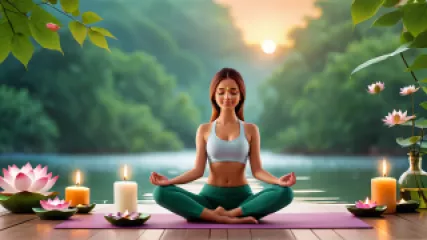The Ultimate Guide to Mastering Self-Care Techniques for Relaxation
The Ultimate Guide to Mastering Self-Care Techniques for Relaxation
In today's fast-paced world, it's more important than ever to prioritize self-care and find effective techniques for relaxation. Whether you're juggling the demands of work, family, or simply the stresses of everyday life, taking the time to nourish your mind, body, and spirit can make all the difference in your overall well-being. In this ultimate guide, we'll explore a comprehensive range of self-care practices and relaxation techniques that can help you achieve a greater sense of calm, balance, and inner peace.
Unpacking the Importance of Self-Care
Self-care is not just a buzzword; it's a fundamental aspect of maintaining a healthy, fulfilling life. When we neglect our own needs and well-being, we risk burnout, increased stress, and a decline in both physical and mental health. By proactively engaging in self-care practices, we can build resilience, boost our mood, and cultivate a deeper connection with ourselves.
Relaxation, in particular, plays a crucial role in self-care. When we're able to find moments of calm and respite, we give our minds and bodies a chance to recharge, recover, and regain a sense of equilibrium. This, in turn, can enhance our ability to navigate the challenges of daily life with greater clarity, focus, and inner strength.
Exploring the Diverse Realm of Self-Care Techniques
The world of self-care is vast and multifaceted, offering a wide range of techniques and practices that cater to different individual needs and preferences. In this guide, we'll dive into several key areas of self-care, each with its own unique approach to relaxation and well-being.
Mindfulness and Meditation
One of the foundational pillars of self-care is the practice of mindfulness and meditation. By learning to be present in the moment and cultivate a sense of inner calm, we can reduce stress, improve focus, and foster a greater sense of inner peace.
Mindfulness meditation, for example, involves the simple act of paying attention to our breath, bodily sensations, and the immediate environment, without judgment or attachment. This practice can help us become more aware of our thoughts, emotions, and habitual patterns, allowing us to respond to life's challenges with greater clarity and equanimity.
In addition to mindfulness meditation, there are various other meditative practices, such as guided imagery, mantra recitation, and body scans, each with its own unique benefits and applications. Experiment with different techniques to find the ones that resonate most with you and your personal preferences.
Movement and Exercise
Another essential element of self-care is the integration of physical activity and movement. Exercise, in all its forms, can be a powerful tool for relaxation and stress management.
From gentle yoga and tai chi to more vigorous workouts like running or cycling, incorporating physical movement into your self-care routine can have a profound impact on both your physical and mental well-being. Movement not only helps to release built-up tension and improve physical fitness, but it can also stimulate the release of endorphins, the body's natural feel-good chemicals, which can have a calming and mood-boosting effect.
Experiment with different types of exercise and find the ones that you genuinely enjoy. Whether it's a leisurely stroll through nature, a restorative yoga session, or a high-intensity workout, the key is to make movement a regular part of your self-care practice.
Creative Expressions
Engaging in creative pursuits can be a powerful avenue for relaxation and self-care. The act of creative expression, whether through painting, writing, music, or any other artistic medium, can help us tap into our inner world, process emotions, and find a sense of flow and calm.
For some, the simple act of doodling or coloring can be a meditative and soothing experience. Others may find solace in journaling, capturing their thoughts and feelings on the page. Musicians may find relaxation in the rhythmic and melodic patterns of their instrument, while visual artists may lose themselves in the act of painting or sculpting.
Experimenting with different creative outlets and finding the ones that resonate with you can be a transformative experience. Allow yourself to be playful, spontaneous, and open to the creative process, without attachment to the final product. The journey itself can be the source of relaxation and rejuvenation.
Nature and Outdoor Experiences
Connecting with the natural world can be a profound and restorative form of self-care. Studies have shown that spending time in nature can have a calming effect on the mind and body, reducing stress, improving mood, and enhancing overall well-being.
Whether it's taking a mindful walk through a local park, hiking in the mountains, or simply sitting and observing the changing seasons, immersing ourselves in the natural environment can be a powerful antidote to the demands of modern life. The sights, sounds, and sensations of nature can have a grounding and centering effect, allowing us to pause, reflect, and reconnect with the rhythms of the earth.
Experiment with different outdoor activities, from gardening and forest bathing to wild swimming and stargazing. Discover the natural spaces that resonate most with you and make them a regular part of your self-care practice.
Social Connections and Relationships
While self-care is often associated with solitary practices, the quality of our social connections and relationships can also have a profound impact on our overall well-being and relaxation.
Nurturing meaningful relationships with family, friends, and loved ones can provide a sense of belonging, support, and emotional fulfillment. Engaging in activities with others, such as sharing a meal, going for a walk, or participating in a hobby together, can help us feel more grounded, connected, and at ease.
Additionally, seeking out social support, whether through a trusted friend, a support group, or a mental health professional, can be a valuable tool for managing stress and finding a sense of calm amidst the challenges of life.
Sensory Experiences and Indulgences
Engaging our senses can be a powerful way to activate the relaxation response and cultivate a greater sense of well-being. From the soothing aroma of essential oils to the calming touch of a warm bath, sensory experiences can have a direct impact on our physiology and emotional state.
Experimenting with different sensory indulgences, such as enjoying a soothing cup of herbal tea, listening to calming music, or treating yourself to a luxurious massage, can help you discover which sensory experiences resonate most with you. These simple pleasures can serve as powerful tools for self-care, allowing you to pause, unwind, and reconnect with the present moment.
Developing a Personalized Self-Care Routine
While the self-care techniques we've explored can be powerful on their own, the true magic happens when you develop a personalized self-care routine that resonates with your unique needs and preferences. The key is to experiment, explore, and find the combination of practices that work best for you.
Start by assessing your current lifestyle and identifying areas where you feel the greatest need for relaxation and rejuvenation. Perhaps you're struggling with stress, experiencing burnout, or simply yearning for more moments of calm and inner peace. Use this as a starting point to curate a self-care routine that addresses your specific challenges and goals.
Remember, self-care is not a one-size-fits-all approach. What works for one person may not be as effective for another. Be open to trying new things, and don't be afraid to adjust your routine as your needs and circumstances change over time.
Incorporating Self-Care into Your Daily Life
Integrating self-care practices into your daily routine can be a game-changer in your journey towards relaxation and well-being. Instead of viewing self-care as a luxury or something you'll "get to eventually," make it a non-negotiable part of your day.
Start small, perhaps by incorporating a brief mindfulness meditation or a short walking break into your workday. Over time, gradually expand your self-care routine, carving out dedicated time for activities that nourish your mind, body, and spirit.
Remember, self-care is not selfish; it's an essential investment in your overall health and happiness. By prioritizing your own well-being, you'll not only experience the immediate benefits of relaxation and rejuvenation, but you'll also be better equipped to show up as your best self in all areas of your life.
Overcoming Obstacles and Embracing Self-Care Consistently
Establishing a consistent self-care practice can be challenging, especially in the face of competing demands and responsibilities. However, with a little determination and a willingness to explore creative solutions, you can overcome the obstacles that may arise.
One common hurdle is the feeling of guilt or the belief that self-care is indulgent or unproductive. It's important to reframe this mindset and recognize that investing in your well-being is a necessary and valuable use of your time. Remind yourself that when you're well-rested, calm, and centered, you're better equipped to tackle the demands of daily life with clarity and focus.
Another obstacle may be the perceived lack of time or resources. However, self-care practices don't have to be time-consuming or expensive. Simple activities like taking a few deep breaths, practicing gratitude, or engaging in a quick yoga session can provide significant benefits. Experiment with micro-practices that can be easily integrated into your daily routine.
Lastly, be patient and kind with yourself. Establishing a consistent self-care practice takes time and commitment. There may be days or weeks where you struggle to maintain your routine. When this happens, don't beat yourself up; instead, gently recommit and find ways to gradually reintegrate your self-care practices into your life.
Embracing the Transformative Power of Self-Care
As you embark on this journey of exploring and mastering self-care techniques for relaxation, remember that the true power lies in your willingness to prioritize your own well-being. By taking the time to nurture your mind, body, and spirit, you'll unlock a newfound sense of resilience, clarity, and inner peace.
Self-care is not a luxury, but a necessity for a fulfilling and balanced life. Embrace the transformative power of these practices, and allow them to become a cornerstone of your personal growth and development. With each step you take towards greater relaxation and self-care, you'll not only improve your own well-being but also inspire and empower those around you.
So, take a deep breath, explore the diverse realm of self-care techniques, and commit to making your well-being a top priority. The journey ahead may have its challenges, but the rewards of a more relaxed, centered, and fulfilled life will be well worth the effort.
Conclusion: Unlocking the Path to Relaxation and Well-Being
In this ultimate guide, we've delved into the world of self-care techniques for relaxation, empowering you with a comprehensive understanding of the diverse practices and strategies that can help you achieve a greater sense of calm, balance, and inner peace.
Remember, self-care is not a one-time event, but a lifelong journey of self-discovery and personal growth. By incorporating these techniques into your daily life, you'll not only experience the immediate benefits of relaxation but also cultivate a deeper connection with yourself and a stronger foundation for navigating the challenges that lie ahead.
Embrace this journey with curiosity, compassion, and a willingness to experiment. Discover the self-care practices that resonate most with you, and allow them to become a powerful tool for unlocking your full potential and living a more fulfilling, balanced, and relaxed life.
The journey towards mastering self-care techniques for relaxation is a deeply personal one, but it's also a universal need that we all share. By prioritizing our well-being and taking the time to nourish our minds, bodies, and spirits, we can unlock a newfound sense of resilience, clarity, and inner peace that will serve us well in all aspects of our lives.
So, let's embark on this transformative journey together, exploring the diverse realm of self-care practices and discovering the techniques that will help us find the relaxation and rejuvenation we so deeply crave. The path ahead may have its challenges, but the rewards of a more centered, fulfilled, and relaxed life will be well worth the effort.






